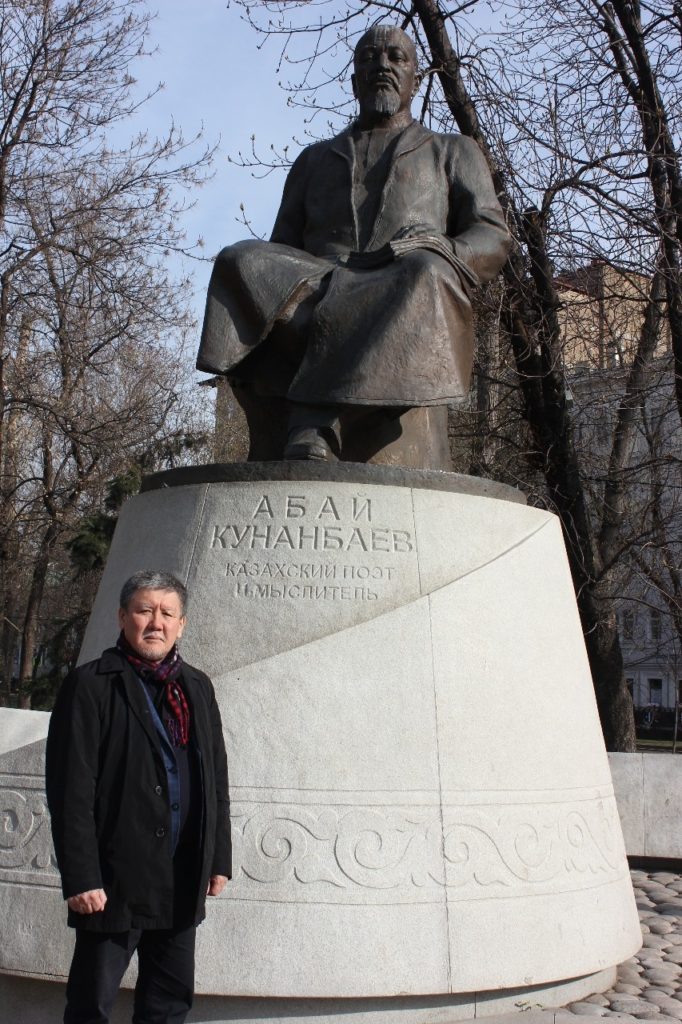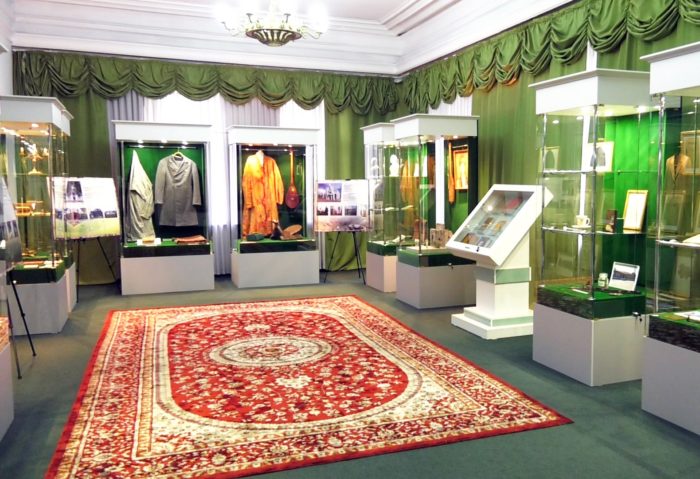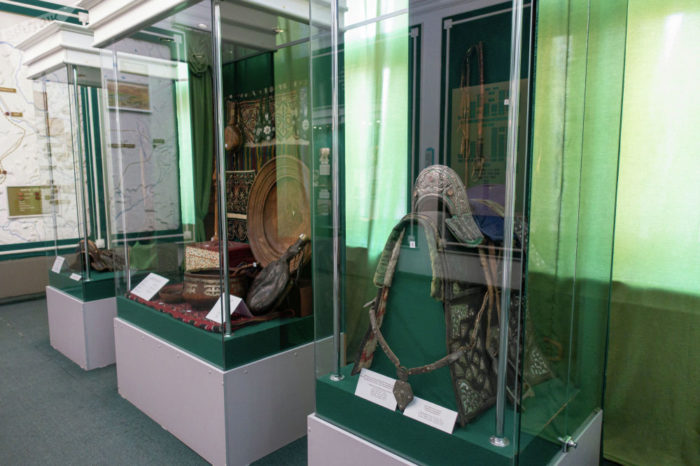This year, dozens of events were held worldwide to mark the 175th anniversary of Kazakh philosopher, poet, educator and founder of written Kazakh literature Abai Kunanbayev.

Photo credit: Press service of the Abai Museum.
The anniversary was also widely celebrated in Kazakhstan. The opening of the Uly Aqyn Abai Uldarymen (Great Poet Abai with Sons) monument became one of the major events in Semei. The monument is located at the Zhidebai-Borili Historical, Cultural and Literary Memorial Museum-Reserve.
Director of the museum Turdykul Shanbai spoke about the museum’s activities and why it is called a spiritual Mecca in an interview for this story.
The heart of the museum
– The Abai Museum was opened 80 years ago to mark the 95th anniversary of the poet. What major events had happened during that time?

Director of the Museum Turdykul Shanbai. Photo credit: Press service of the Abai Museum.
– To begin with, its opening in October 1940 became a true cultural event. For thousands of years, the verbal types of creative activities were popular in the steppe. The literary genre of verbal art like aitys (poetic competitions of bards) is still very popular among the people. Famous and venerable akyns (bards) always filled whole halls and stadiums. Therefore, our people deeply love, feel and understand the words of the outstanding poet and sage-thinker Abai. After all, he raised the verbal art of the Kazakh people, which has a thousand-year history, to a new level, to classic, and expanded its artistic and aesthetic horizons. Thanks to Abai, the horizon of national literature has become even more beautiful and recognizable.
It is indisputable that the Abai Museum can boast about having a rich history. Many know that a local history museum was opened for the first time in Semei in 1883. And Abai took a direct part in this good deed! In 1885, he donated more than 500 exhibits to the opened museum through an exiled friend, the famous doctor Nikolay Dolgopolov. It is sad that not all the exhibits have survived to this day, but a miraculously preserved collection of seventeen items forms the basis of the modern Abai museum. One can say this is the heart of the museum.

– What is the Abai Museum in the 21st century?
– Now it is a whole museum complex, at the origins of which stood outstanding people such as the classic of Kazakh literature Mukhtar Auezov and the talented scientist Kanysh Satpayev. It includes nine expositions or, more precisely, branches. The main museum is located in Semey and consists of the main building, the Research Center of Abai Studies and the mosque-madrasa (college) of Akhmet Riza, where Abai studied in his youth. It is unique both in content and in material embodiment.
– What exactly?
– First, we tried to visualize the era and the way of life of the people of the era as much as possible. The second most important component was the museum’s interactivity. This is especially designed for young visitors who are interested in touching and twisting everything. Most importantly, today the Abai Museum is called upon not only to preserve the memory of the outstanding poet, but rather to mainstream his heritage, to promote understanding of his work by new generations of readers. This is exactly what the Kazakh President wrote in his article “Abai and Kazakhstan in the 21st century.”

This year, the museum was significantly restored and modernized with the budget allocated by the government. A large-scale work has been done in a short time. The overall infrastructure has improved. And the townspeople have already appreciated the spacious, comfortably landscaped museum territory. We see their happiness when they walk here with their children, bring their guests, admire the new monument, one way or another talking about Abai. A literary cafe was also opened, where people come to chat in a cozy atmosphere.
The museum preserves the legacy of the outstanding personalities of our country, and all this is presented using the latest technologies. We have audio guides, touch-sensitive panels, LED-screens, multimedia rooms and many other technical possibilities and novelties. For example, in the multimedia room it is possible to watch all the films and performances that Abai created over the years or listen to all the songs. Visitors can choose the content they are interested in and watch it in headphones, without disturbing others.

Place of pilgrimage and worship
– What festive events have taken place at the Zhidebai-Borili and what events are scheduled?
– Due to the pandemic, 80 percent of the events are held online. Before the introduction of quarantine restrictions, we managed to organize and hold mobile exhibitions in more than ten cities of Kazakhstan, then we held several national and international conferences. Together with Turkish television, we shot a documentary that will be broadcast in 50 countries around the world. With friends from Russia, with the support of the Embassy of Kazakhstan in Russia, we prepared a wonderful folio called “Knowledge of Abai – Knowledge of Oneself.” Now, together with the Abai Academy in Nur-Sultan, we are preparing and planning to publish the international atlas “Zhidebai” in London.
– Can you single out the most grandiose and brightest events dedicated to the anniversary?
– The Kazakh government announced Aug. 10 (the date of birth of Abai) as an official holiday – the Day of Abai, naming him the “spiritual reformer” of Kazakhstan. This event gives us an opportunity for an even deeper study, understanding and popularization of his legacy. Another important event is the opening of the monument to Abai and his sons Akylbai and Turagul at the entrance to the main building. The monument was made based on the only surviving photograph of the poet with his sons.
– Is it true that the museum has become a spiritual Mecca for visitors? What attracts people to this site?
– The Abai Museum has become the main attraction of our region. And Zhidebai, as the place where the poet was born, is indeed becoming a spiritual and cultural center of attraction for people from different continents. This task was outlined back in 1995 at the opening of the memorial complex by Kazakhstan’s First President Nursultan Nazarbayev, who said that the museum will always be a place of pilgrimage and spiritual worship for Kazakhs. This is now true today.
First, I think that people are attracted by the genius of Abai. The Abai Museum is a museum of wisdom, his heritage is a common human property. Enlightened visitors come hoping to learn and see something new about him and his surroundings. People are interested in understanding how the outstanding poet and thinker lived. Everyone is also interested in the new exhibition solution.
– Who are the guests of the museum?
– That’s a very good question. First, there are Semey citizens and their guests and relatives from other cities and countries, for whom the museum is one of the main attractions of the city. The good news is that today there are many young people among them. Not the young people brought by curators or teachers, but rather those, who are interested and visit the museum voluntarily. I think young people are attracted by the modern style of the museum.
A path to knowledge
– The main fund of the museum has more than 13,000 exhibits presented in 11 thematic halls. Which ones are the most unique and why?
– We do not have non-unique exhibits and each of them is priceless in its own way. For example, a door. In his youth, Abai studied at the Akhmet Riza madrasa (college). In the “atheistic” period of the history of our country, this madrasa, like many mosques and temples, was burned down, and later it was restored. Now the madrasa and mosque of Akhmet Riza is located in the main building of the museum complex. The entrance door to the madrasa is one of the few things that survived. Every time I pass by and touch it, I experience an extraordinary feeling, as if I were touching Abai himself. Now I am writing an essay on this topic. The working title is “The Door to Knowledge.”
– Is there a favorite and most visited place?
– Today, the most popular place in the museum is the “Words” hall, where Abai, thanks to modern technologies, gives the visitor his bata (blessing). The visitor, in turn, according to the tradition of our people, opens his palms to receive the blessing from the sage. The people consider it a great honor to receive a blessing from Abai himself. By the way, Abai is voiced by an actor who passed a special selection competition. Visitors leave this hall especially elated, feeling the presence of Abai himself.
– You collect stories and legends about the poet and thinker. Tell us about some of the most unusual ones.
– The fate of Abai is not just the fate of a genius poet. His is the fate of the entire people. Therefore, every fact of his difficult biography seems to me legendary. For example, there is a story that highlights this. Abai possessed a truly amazing memory. When he started speaking, one of the first questions was: “Mom, when I was born, why was everything red and pink at home?” Later, Ulzhan’s mother recalled, not without surprise, that on that day they really painted the felt and hung it everywhere to dry. I think remembering yourself from the very beginning is an extraordinary gift. This fact became known from the book “Ulylar Mekeni” (“Land of the Greats”) by the famous researcher of Abai’s life Beken Isabayev, who heard this story from the mouth of old-timers.
– What, in your opinion, are Abai’s most valued teachings to all generations and for all centuries?
– In his works, Abai often used the phrase “Adamzattyn barin sui bauyrym dep” (“Love all humanity as your brother”). Only sincere love for people can make these words relevant and touching. Abai himself completely loves humanity. He says that “Without love, life is empty,” that “the Creator created man with love,” and therefore people should love each other, and not shoot and kill. In my understanding, Abai is a humane person.
Seven vectors of development
– The last question is about plans and prospects. How to raise the museum complex to an even higher level, and what is being done to achieve this?
– President Tokayev in his “Abai and Kazakhstan in the 21st century” article set the task to transform the museum-reserve into a full-fledged research center. Today we have prepared a new scientific concept of the museum, which consists of seven areas of focus.
Firstly, the preparation of a 100-volume research collection “Questions of Abai Studies” is a priority. The first 10 volumes should be published this year. Secondly, the conceptual direction is the preparation and publication of the encyclopedia “Museum of Abai. 80 years.” As part of the fundamental direction, the monograph “Hakim Abai and the figures of Alash” has already been published and a biographical chronicle of Abai’s life has been prepared.
The fourth direction is educational and methodical ones. This is a joint research work with school students, which includes an annual traditional publication of the best works of schoolchildren and participants in a creative competition. The release of the Zhidebai illustrated atlas is also planned soon.
Systematic direction focuses on the organization of exhibitions, presentations, meetings, literary evenings, circles, museological work, and the publication of booklets, brochures, calendars and postcards.
Finally, the events include the organization of conferences, television shows, lectures, interviews, and expeditions.
And this is not just a plan. We paid special attention to scientific research by opening the Research Center of Abai Studies at the museum. It is difficult to imagine the modern cultural space of a museum without science being present. The President gave us instructions, we are fully aware of the responsibility of the task, therefore we work systematically to finish the work.
As a specialist in the preparation of encyclopedic publications, I personally prepare several monographs – “Philosophy of the Abai Museum”, “Hakim Abai and the Leaders of the Movement Alash” (Philosophy of Freedom).” An illustrated encyclopedia titled “Museum of Abai” is being prepared under my guidance. Young employees of the museum are actively developing themes and preparing such publications as “Pulse of the Museum”, “Eighty Facts from the History of the Museum of Abai”, and so on.
The article was originally published in Russian on Profile.ru website.

